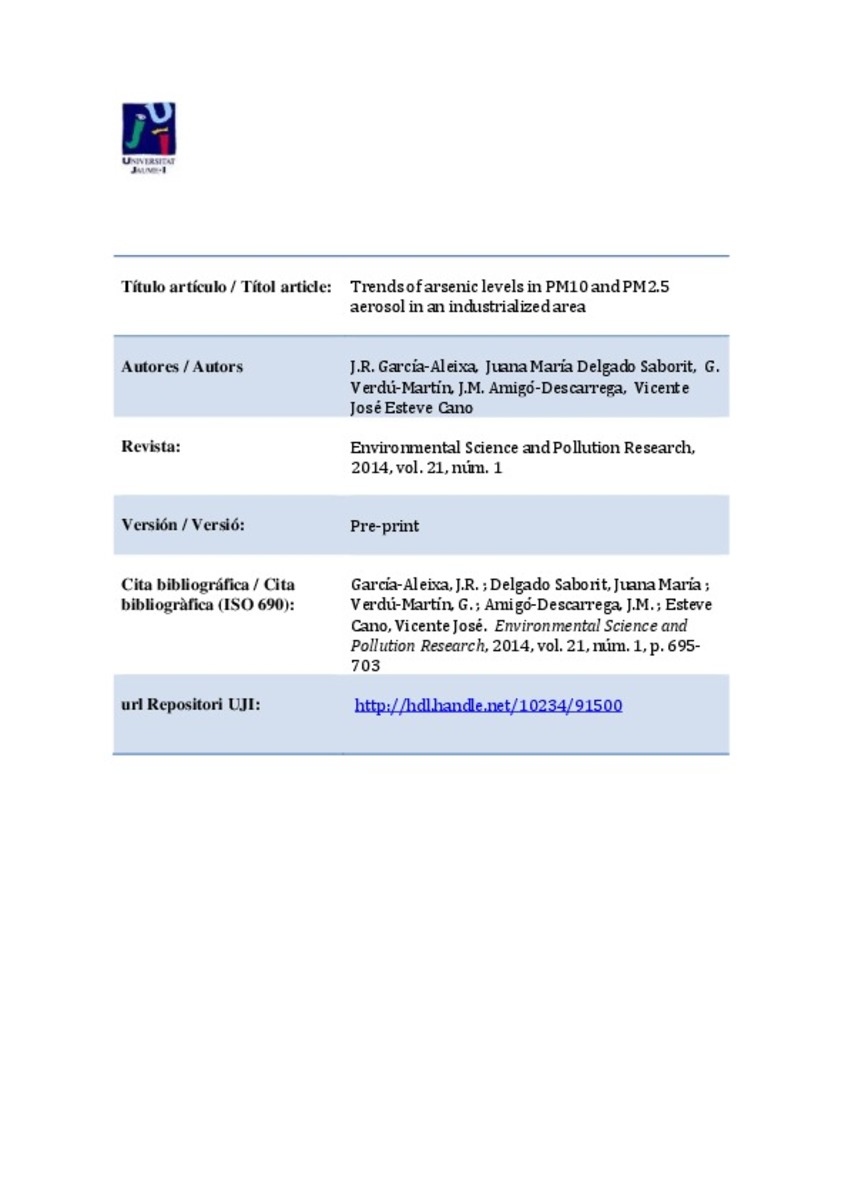Mostrar el registro sencillo del ítem
Trends of arsenic levels in PM10 and PM2.5 aerosol in an industrialized area
| dc.contributor.author | García-Aleixa, J. R. | |
| dc.contributor.author | Delgado-Saborit, Juana Maria | |
| dc.contributor.author | Verdú Martín, G. | |
| dc.contributor.author | Amigó Descarrega, J. M. | |
| dc.contributor.author | Esteve-Cano, Vicente | |
| dc.date.accessioned | 2014-05-06T17:54:56Z | |
| dc.date.available | 2014-05-06T17:54:56Z | |
| dc.date.issued | 2014 | |
| dc.identifier.issn | 0944-1344 | |
| dc.identifier.issn | 1614-7499 | |
| dc.identifier.uri | http://hdl.handle.net/10234/91500 | |
| dc.description.abstract | Arsenic is a toxic element that affects human health and is widely distributed in the environment. In the area of study, the main Spanish and second largest European industrial ceramic cluster, the main source of arsenic aerosol is related to the impurities in some boracic minerals used in the ceramic process. Epidemiological studies on cancer occurrence in Spain points out the study region as one with the greater risk of cancer. Concentrations of particulate matter and arsenic content in PM10 and PM2.5 were measured and characterized by ICP-MS in the area of study during the years 2005–2010. Concentrations of PM10 and its arsenic content range from 27 to 46 μg/m3 and from 0.7 to 6 ng/m3 in the industrial area, respectively, and from 25 to 40 μg/m3 and from 0.7 to 2.8 ng/m3 in the urban area, respectively. Concentrations of PM2.5 and its arsenic content range from 12 to 14 μg/m3 and from 0.5 to 1.4 ng/m3 in the urban background area, respectively. Most of the arsenic content is present in the fine fraction, with ratios of PM2.5/PM10 in the range of 0.65–0.87. PM10, PM2.5, and its arsenic content show a sharp decrease in recent years associated with the economic downturn, which severely hit the production of ceramic materials in the area under study. The sharp production decrease due to the economic crisis combined with several technological improvements in recent years such as substitution of boron, which contains As impurities as raw material, have reduced the concentrations of PM10, PM2.5, and As in air to an extent that currently meets the existing European regulations. | ca_CA |
| dc.format.extent | 18 p. | ca_CA |
| dc.format.mimetype | application/pdf | ca_CA |
| dc.language.iso | eng | ca_CA |
| dc.publisher | Springer Verlag | ca_CA |
| dc.relation.isPartOf | Environmental Science and Pollution Research, 2014, vol. 21, núm. 1 | ca_CA |
| dc.rights | © Springer, Part of Springer Science+Business Media “The final publication is available at link.springer.com” | ca_CA |
| dc.rights.uri | http://rightsstatements.org/vocab/InC/1.0/ | * |
| dc.subject | Arsenic | ca_CA |
| dc.subject | Atmospheric particles | ca_CA |
| dc.subject | PM2.5 | ca_CA |
| dc.subject | PM10 | ca_CA |
| dc.subject | Ceramic industry | ca_CA |
| dc.title | Trends of arsenic levels in PM10 and PM2.5 aerosol in an industrialized area | ca_CA |
| dc.type | info:eu-repo/semantics/article | ca_CA |
| dc.identifier.doi | http://dx.doi.org/10.1007/s11356-013-1950-0 | |
| dc.rights.accessRights | info:eu-repo/semantics/openAccess | ca_CA |
| dc.relation.publisherVersion | http://link.springer.com/article/10.1007%2Fs11356-013-1950-0 | ca_CA |
Ficheros en el ítem
Este ítem aparece en la(s) siguiente(s) colección(ones)
-
QUIO_Articles [690]
Articles de publicacions periòdiques







